Jeppesen 02B - Reciprocating Engine Removal and Overhaul
1/377
There's no tags or description
Looks like no tags are added yet.
Name | Mastery | Learn | Test | Matching | Spaced |
|---|
No study sessions yet.
378 Terms
Time between overhauls (TBO).
By tracking the service life of several different engines, it is possible for manufacturers to establish a recommended:
14 CFR Part 91
Aircraft owners who operate under what FAR regulation are not obligated to comply with a manufacturer's recommended TBO?
FAA airworthiness regulations require the operator to adhere to TBO or the maximum time in service established in their operating manuals.
If an aircraft is operated for hire in an air taxi operation:
Total time (TT).
Anytime maintenance is done on that engine, a logbook entry is made referencing the ___________ the engine has accumulated since it was new.
An overhaul should be accomplished and total time records should be continued without interruption.
What practice should be done after an engine reaches its TBO?
The amount of time since major overhaul (SMOH).
Accumulated engine operation time should be referenced as:
Shorten the useful life of an engine.
Operating at maximum power settings for prolonged periods of time, frequent starts in extremely cold temperatures, and lack of preventative maintenance can:
Sudden stoppage.
It is defined as a very rapid and complete arrest of the engine.
Engine rpm drops to zero in less than one complete propeller revolution.
What happens in a typical sudden engine stoppage?
A complete engine teardown and inspection.
When a sudden stoppage occurs, an engine manufacturer's instructions usually require:
Sudden reduction in engine speed.
It occurs when one or more propeller blades strike a movable object such as a runway light, tool box, hangar, or another aircraft.
Sudden reduction in engine speed.
When this occurs, engine rpm drops rapidly until the object struck is cleared. However, the engine continues to run and the rpm typically returns to its previous value.
The engine should be shut down as quickly as possible to prevent further damage.
What practice should be done whenever a sudden reduction in engine speed occurs?
Very little internal damage typically results.
What happens if the sudden speed reduction occurs at a low rpm?
Severe internal engine damage.
What happens if the sudden speed reduction occurs at a high rpm?
A thorough external inspection of the engine mounts, crankcase, and, if applicable, the nose section.
What is the minimum required practice that should be done when an engine is subjected to a sudden reduction in speed?
Removing the propeller and check for misalignment of the crankshaft, or propeller drive shaft on engines using a propeller gear reduction.
This task is performed by attaching a dial indicator to the front of the engine case and letting the indicator arm ride on the crankshaft as it is turned.
At the outside edge of the flange
Engines with flange-type propeller shafts must be checked:
At both the front and rear cone seats.
Spline-type propeller shafts should be checked:
Runout.
The amount a shaft is misaligned is referred to as its:
The limits specified in the manufacturer's maintenance manual.
The runout tolerance must fall within:
The crankshaft must be removed and replaced.
What practice should be done if the runout is excessive?
Install a serviceable propeller and check the propeller tracking.
What practice should be done if the crankshaft runout does not exceed the manufacturer's established limits?
If no indication of internal failure is found after 20 hours of operation, the engine probably requires no further special inspections.
Which statement is true regarding the completion of inspection of an engine that was subjected to a sudden speed reduction?
Internal failure.
The presence of an excessive number of metal particles in an engine oil filter or screen or in the oil itself generally indicates:
It will disintegrate.
One way to determine if a particle is metal or carbon is to place the material on a flat metal object and strike it with a hammer. What happens if the particle is carbon?
It will remain intact or change shape, depending upon its malleability.
One way to determine if a particle is metal or carbon is to place the material on a flat metal object and strike it with a hammer. What happens if the particle is metal?
Ferrous metals.
If you find some particles that are metal, use a magnet to determine whether the particles are ferrous or nonferrous. These particles are typically produced by wearing piston rings.
Non-ferrous metals.
If you find some particles that are metal, use a magnet to determine whether the particles are ferrous or nonferrous. These particles are typically produced by main bearings.
Spectrometric Oil Analysis Program (SOAP).
A way to correctly identify the type and quantity of foreign particles in an engine's oil which requires an oil sample to be sent to a laboratory for analysis. When this is done, you are provided with a list of the type of particles found along with possible sources of the particles.
Spectrometric Oil Analysis Program (SOAP).
The image shown is:
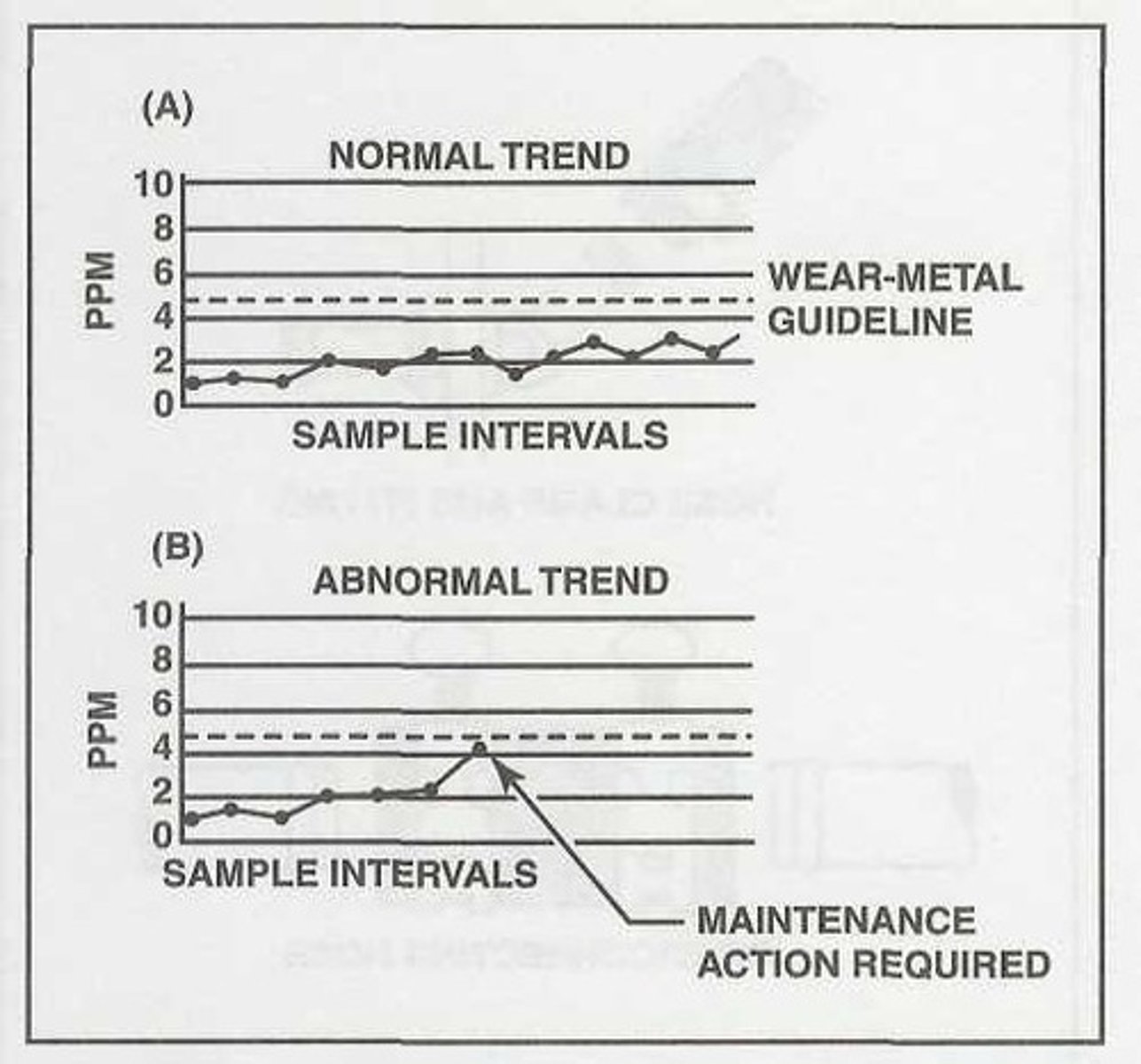
Removal of an engine.
Excessive engine vibration, back firing, afterfiring, cutting out while in flight, and low power output are all symptoms of one or more problems that require:
Engine removal should be done in a well-ventilated area with at least one fire extinguisher nearby.
When an engine is removed from an aircraft, flammable fluids often leak from the engine and create a fire hazard. Therefore, what practice should be done during engine removal?
Landing gear shock struts may need to be deflated to prevent damage from over-extension.
What practice should be done during engine removal if the aircraft has tricycle-type landing gear in addition to the attached tail support?
In the OFF position.
Before starting the engine removal process, make sure that the magneto switch is:
Magneto switch in OFF position and removing at least one spark plug from each cylinder.
When these steps are taken during the engine removal process, you eliminate the chance of the engine suddenly kicking back or starting when the propeller is turned.
The battery is normally removed and taken to a battery shop where it can be cleaned, serviced, and charged.
Which statement is true regarding batteries during engine removal if the aircraft will be out of service for more than a few days?
Once the magnetos and battery are disarmed.
When should draining oil be done?
Removing one or more oil drain plugs or opening a drain valve.
Most of the engine oil in a typical horizontally opposed engine is drained by:
One person can typically conduct the operation safely with no additional equipment.
Which statement is true when removing a fixed pitch propeller from a light aircraft?
The use of a propeller sling with a frame and hoist is imperative.
Which statement is required when removing a large constant speed propeller?
Begin disconnecting and draining the remaining fuel and hydraulic lines.
What practice is done once the oil is drained and the propeller is removed?
The carburetor must also be drained.
Which statement regarding carbureted engines once the fuel line is removed?
Flexible rubber hose that must be drained once removed.
Most fuel lines are constructed of:
B-nut.
Fluid lines are typically connected to the firewall or accessory by a:
The fuel line should be plugged or covered with moisture-proof tape.
What practice is done after a fuel line has drained?
All lines and fittings should be labeled to help prevent possible confusion when reinstalling them on a new engine.
Which statement is true once fuel lines has been plugged and covered with moisture-proof tape?
To help prevent accidental disconnection during aircraft operation, the plug assembly screws to the receptacle assembly and is secured with safety wire.
Which statement is true regarding AN or MS electrical connectors?
One type consists of a junction box containing terminal strips with terminal posts while a second type consists of a plug-type connector such as a Cannon plug or Amphenol connector.
On aircraft that utilize firewall electrical disconnect points, there are generally two kinds of electrical disconnects used. Which statement is true regarding electrical disconnection?
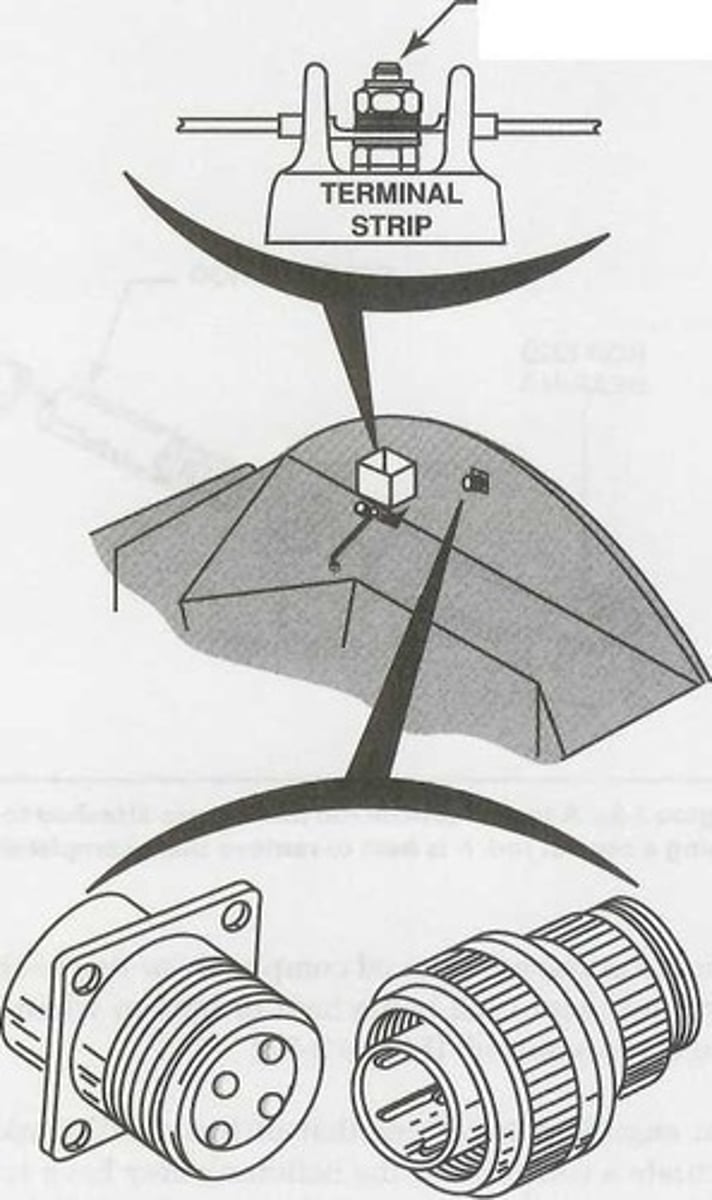
Utilize knife-type or wrist-lock connectors that are sealed in some type of protective sheathing.
Which statement about electrical disconnection is true regarding small aircraft with simple electrical systems?
Wrap them with moisture-proof tape whenever they are disconnected.
What practice should be done to protect the exposed ends of electrical connectors from dirt and moisture?
The engine control rods and cables allow operation of the throttle and mixture from within the cockpit.
Which statement is true regarding throttle and mixture operation?
Begin by removing the cotter pin and castle nut and then remove the bolt passing through the control assembly.
What practice is done when removing a control rod?
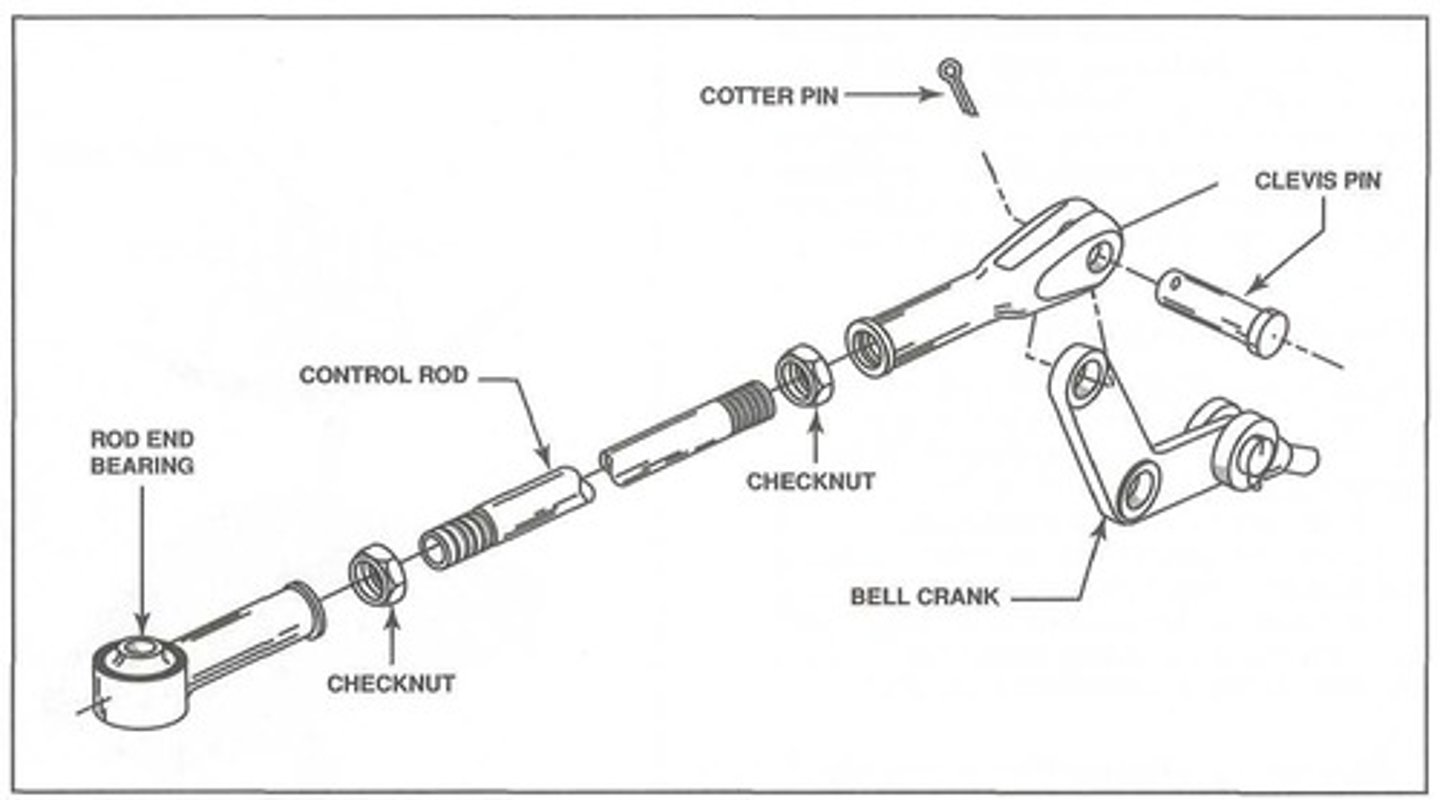
The control rod must be removed completely from the aircraft before the engine is removed.
A typical control rod has a clevis attached to one end and a rod end bearing attached to the other end. What best practice is done to prevent damaging a control rod?
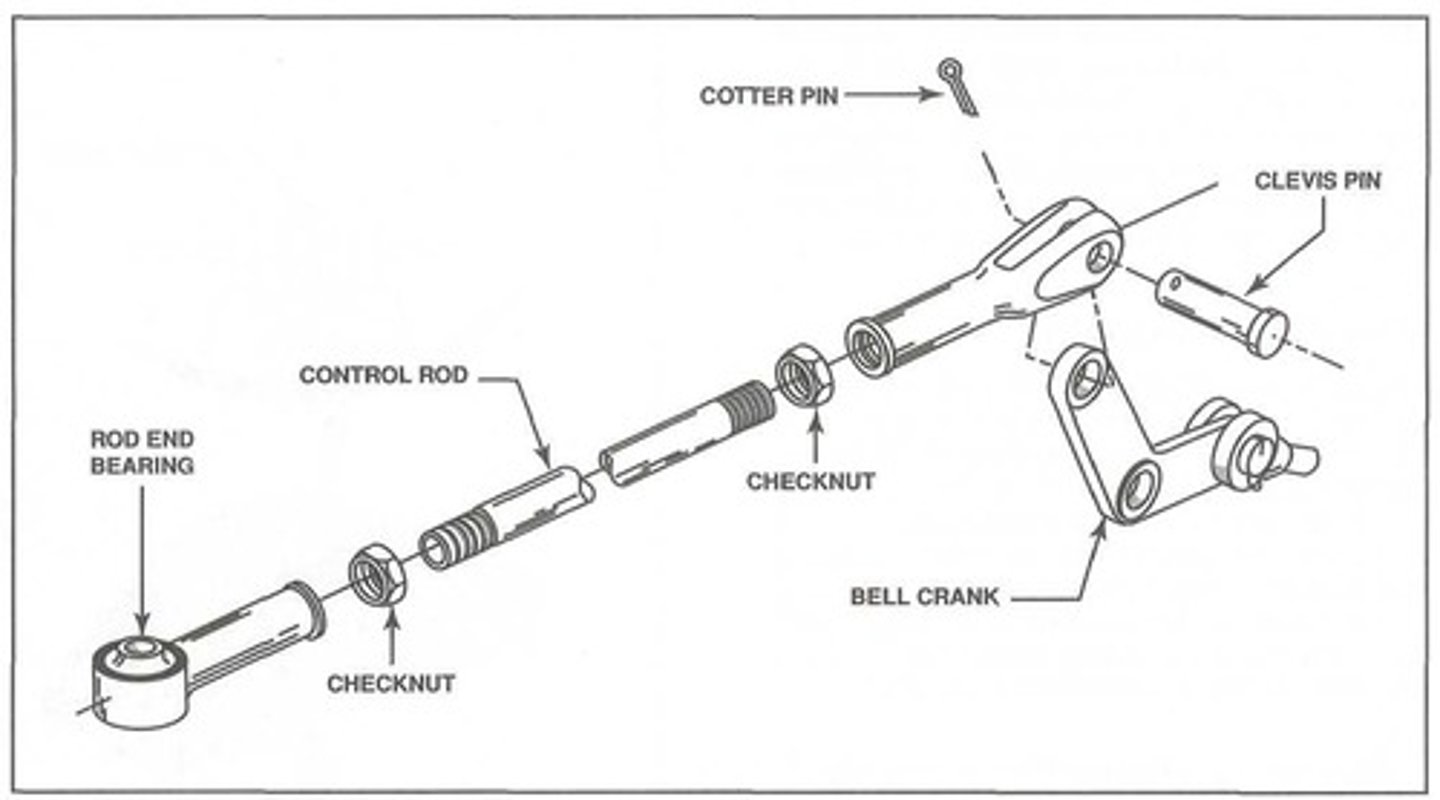
The bellcrank may have to be removed to allow removal of a control rod.
Which statement is true on engine installations that utilize a bellcrank to actuate a control rod?
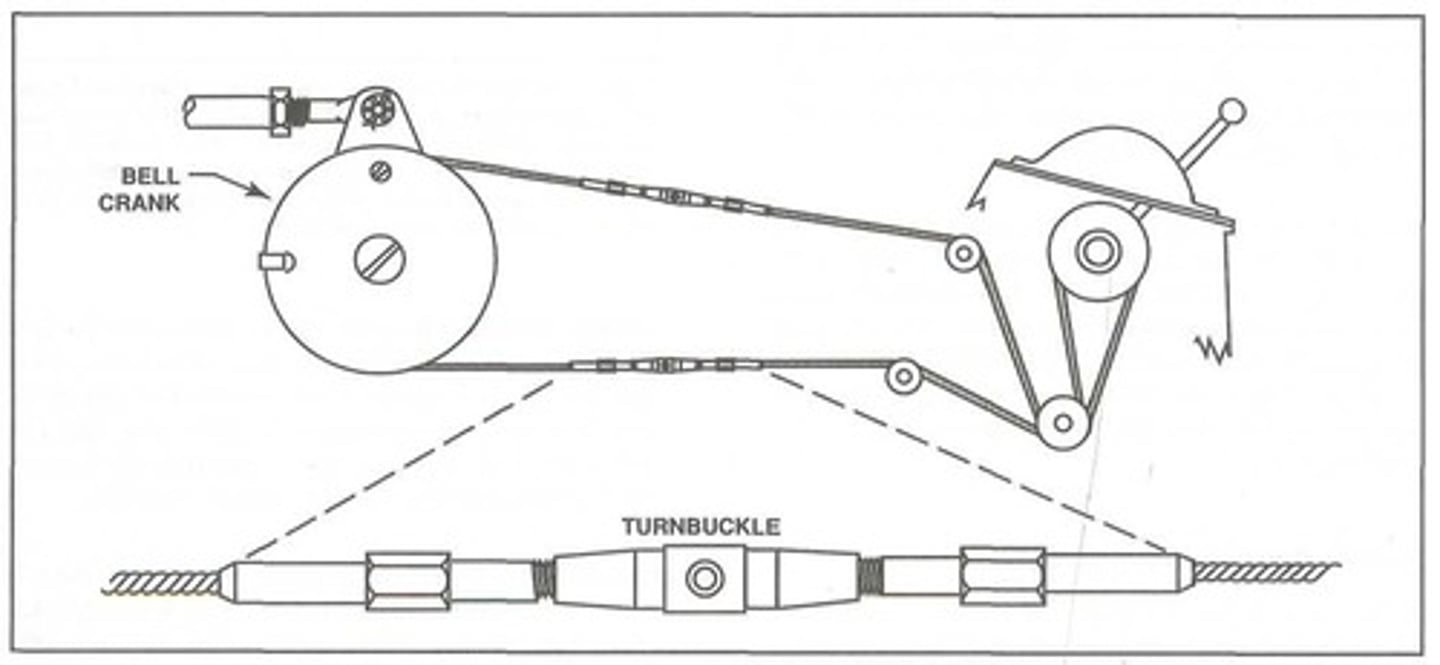
The cable assembly may have to be separated at a turnbuckle in order to remove the control rod.
Some control systems in use today consist of a cable and pulley arrangement to actuate engine controls. What practice is done to remove the control rod?
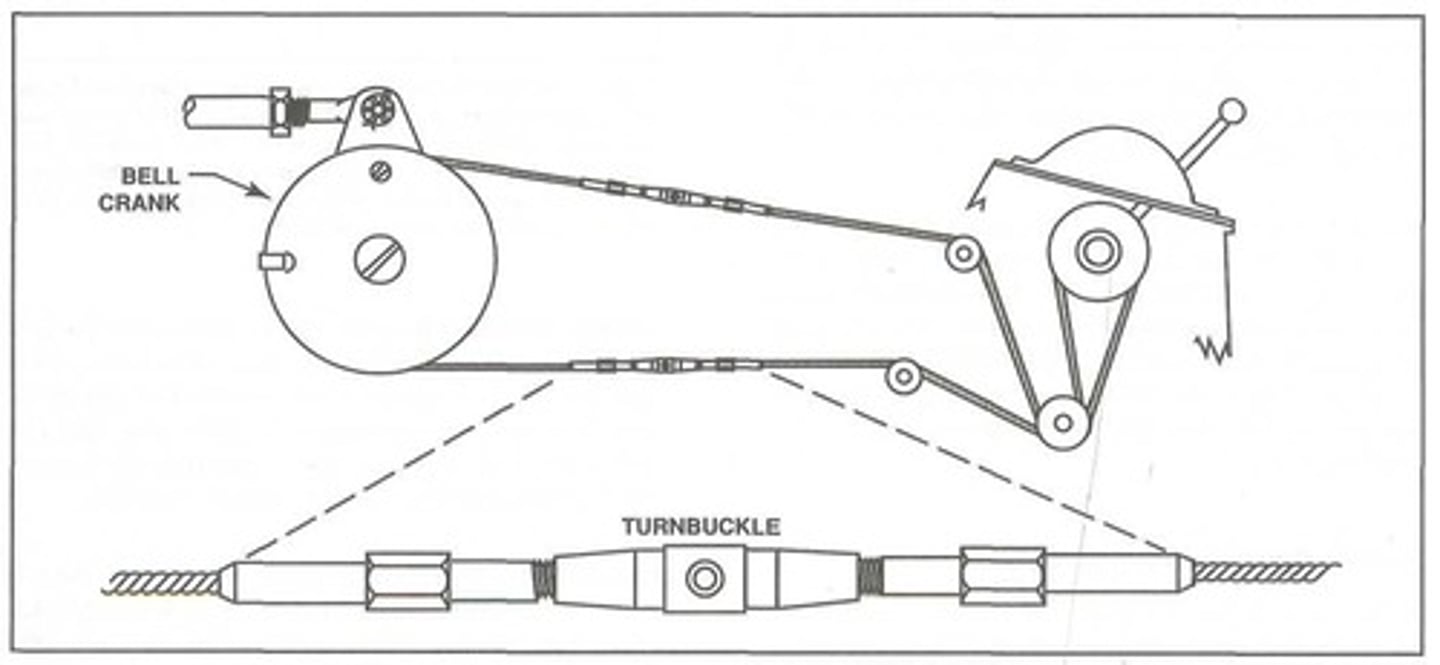
Mark the position of the control cable end threads at the turnbuckle.
What practice is best done before you remove the turnbuckle in this picture?
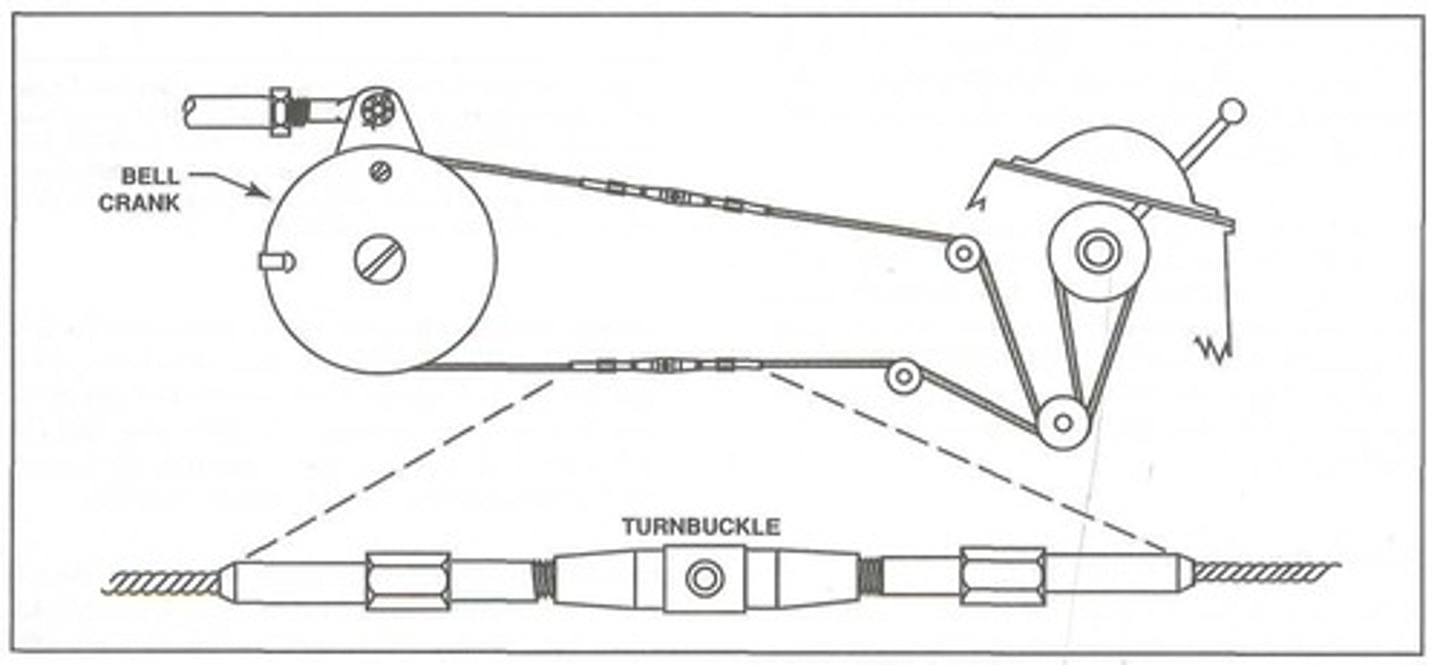
The engine is ready for hoisting.
Which statement is true after all engine connections are free and clear?
The engine is removed without the engine mount.
Which statement best describes engine removal for a typical overhaul?
The mount must be removed with the engine. The separation point is usually the firewall.
Which statement best describes engine removal if the engine is being replaced with a quick engine change assembly (QECA)?
Quick engine change assembly (QECA).
It is essentially a powerplant with the necessary accessories already installed on the engine mounting assembly.
The mount including the engine nacelle must be removed with the engine. The separation point is usually the firewall.
Which statement best describes engine removal if a radial engine is being replaced with a quick engine change assembly (QECA)?
Make sure the hoist can reach the engine with adequate clearance and is rated for the weight of the engine being lifted.
What practice should be done when choosing a hoist and frame assembly?
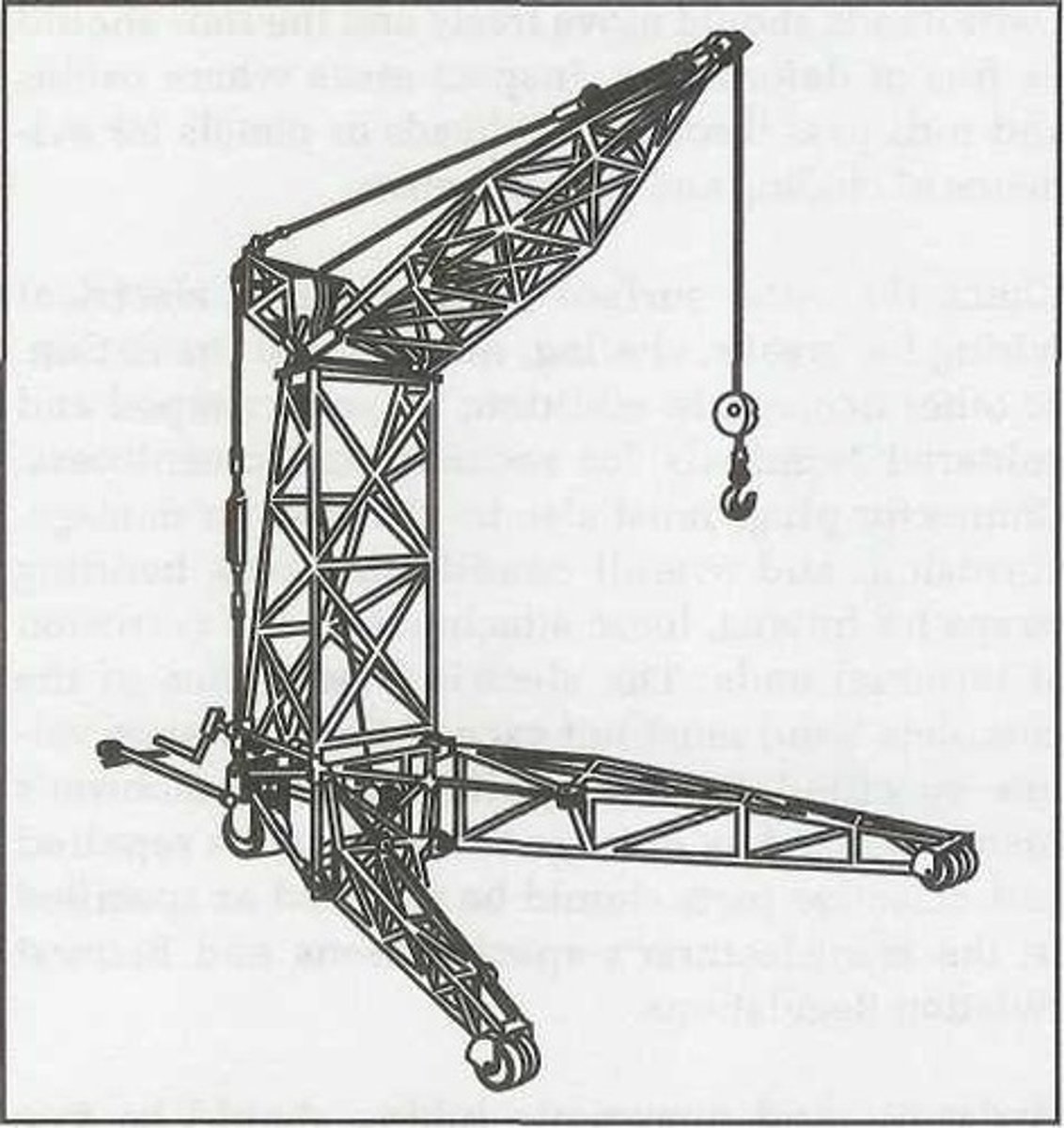
Recheck the aircraft tail supports and wheel chocks.
What practice should be done before you actually begin lifting an engine?
Be sure that the engine is steadied and secure with no lateral loading.
What practice should be done when raising the engine enough to remove the engine weight from the engine mount before the last nuts are removed?
Investigate the reason and maneuver the engine as necessary until it slips free.
What practice should be done when gently moving the engine free of the mount attachments if the engine binds at any point?
Inspect the entire engine nacelle for corrosion, cracks, missing rivets, or any other visible defects.
How do you begin the inspection of the engine compartment?
Cracks in the cowling or ducts can be stop-drilled or patched if they do not exceed limits specified in the manufacturer's structural repair manual.
Which statement is true regarding cracks in the cowling?
The electrical resistance of the complete bond must not exceed the resistance values specified in the applicable manufacturer's instructions.
Which statement is true when checking bonding straps for fraying, loose attachments, and corrosion at terminal ends?
Dents should be worked out, and anti-chafing strips should be replaced if they have pulled loose or no longer form a tight seal.
Which statement is true when checking all air ducts for dents and the condition of the fabric or rubber anti-chafing strips at their joints?
Weather checking.
It is a cracking of the outside covering of hoses that sometimes penetrates to the reinforcement webbing.
Cold flow.
It refers to deep and permanent impressions or cracks caused by hose clamps.
The oil tank is generally removed to permit thorough cleaning and the oil cooler and temperature regulator are usually removed and sent to a repair facility for overhaul.
Which statement about engine removal is true if the engine installation employs a dry sump oil system?
An inspection of the engine mount structure must be accomplished.
What practice is done before a new or overhauled engine can be installed on an aircraft?
Dye penetrants are used to help reveal cracks, porous areas, or other defects.
Which practice is usually done when checking the engine mount for bends, dents, flat spots, or elongated bolt holes?
Check by magnetic particle inspection.
Which practice is done when checking the ferrous parts of the engine mount for bends, dents, flat spots, or elongated bolt holes?
Engine mount structures consisting of riveted aluminum.
These aluminum mount structures usually provide two mounting rails to which the engine is mounted and are typically used for mounting large horizontally opposed engines, especially on multi-engine aircraft.
Steel tube engine mount structures.
Mounts that are used on both large and small, horizontally opposed, and radial engines. These mount structures bolt to the engine firewall and their shape provides some separation between an engine and firewall.
Dynafocal engine mounts.
Most modern reciprocating engine aircraft utilize these engine mounts. The engine mounting points are turned inward so they point toward the engine's center of gravity. This design helps prevent the transmission of engine vibration to the airframe.
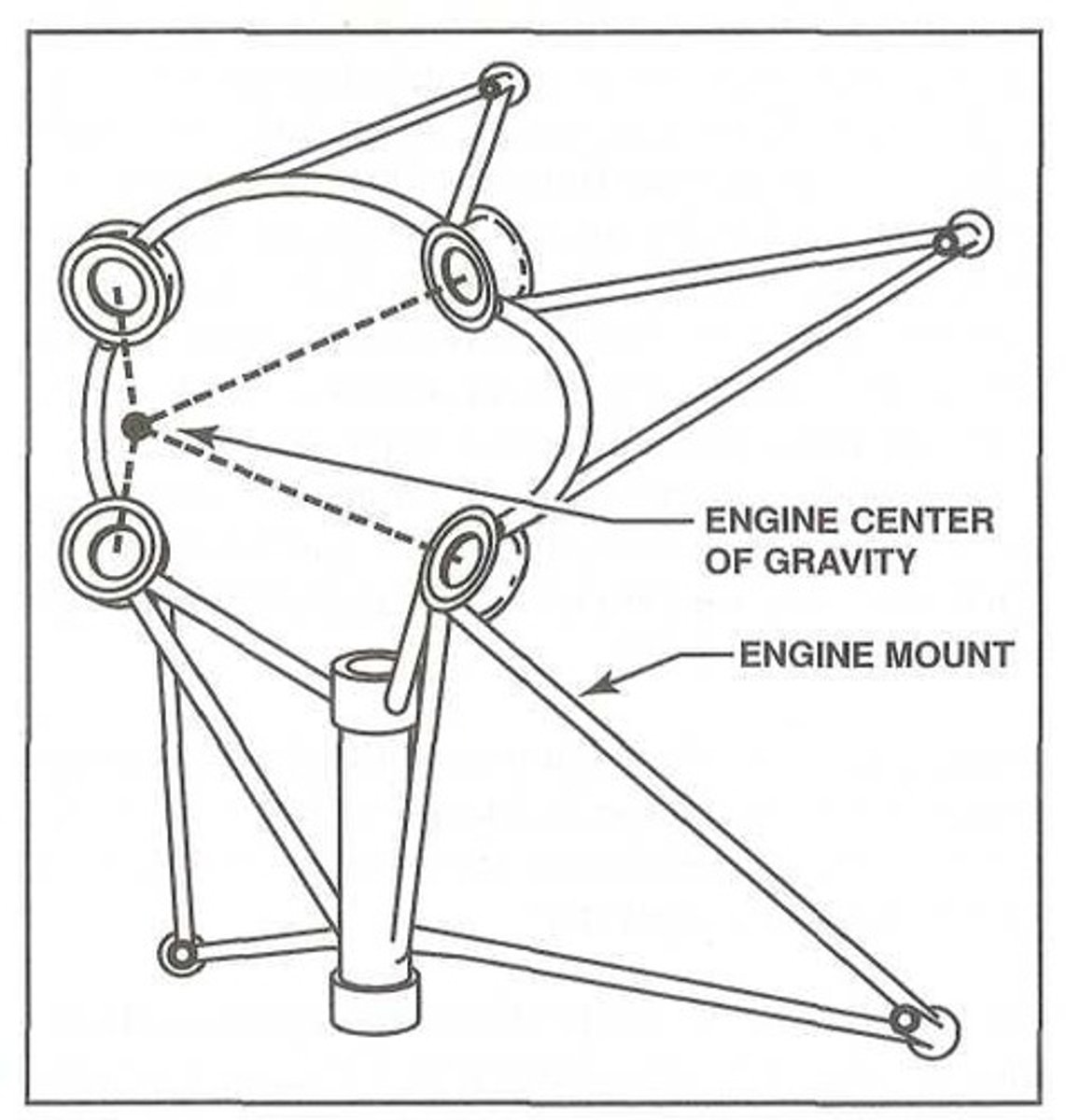
Shock mounts.
A typical engine mounting structure incorporates vibration isolating ___________ that help dampen engine vibrations and permit restricted movement. They contain rubber components that are arranged so the engine weight rests on the rubber.
Disassemble the engine and perform a complete and thorough inspection.
What is the best way to identify parts that are defective or worn beyond airworthy limits?
Top overhaul.
It is defined as an overhaul of those parts associated with the engine cylinders.
The cylinders, pistons, and valve operating mechanisms are reconditioned while the piston rings are replaced.
What happens during a typical top overhaul?
Remove as few parts as necessary to gain access to the cylinders
What practice is done when performing a top overhaul to gain access to the cylinders?
More durable materials are now available.
Why are top overhauls are not performed as frequently in modern aircraft engines as in earlier models?
Some engine manufacturers believe that if you are going to remove all of an engine's cylinders, it is relatively inexpensive to overhaul the rest of the engine.
Why is a top overhaul not universally recommended?
Major overhaul.
This overhaul entails a complete engine reconditioning at periodic intervals.
Manufacturer recommendations or an FAA approved number of accumulated hours since new or last major overhaul.
How is the exact interval of a major overhaul determined?
The amount of hours indicating the time since major overhaul should be added to the engine log.
It is important to note that the total time on an engine must be continued when it is overhauled. Which statement best support this?
Zero time.
Only new engines and rebuilt engines are granted what kind of status?
14 CFR Part 43.
This FAR regulation describes a rebuilt engine as an engine that has been disassembled, cleaned, inspected, repaired as necessary, reassembled, and tested to the same tolerances and limits as a new engine.
A rebuilt engine can contain either new or used parts that conform to new part tolerances and limits or to approved oversized or undersized dimensions.
Which statement best describes the parts installed in a rebuilt engine?
If the engine manufacturer or an agency approved by the manufacturer performs the work.
When can an engine only be rebuilt and carry a zero time status?
Zero time.
This status allows the owner or operator to start a new maintenance record with no reference to previous operating history.
Remanufactured engine.
Advertisements for engine overhauls or exchange programs sometimes use this term. This term is not defined by the FAR and the vendor should be questioned about what is meant.
Research the airworthiness directives and manufacturer's service bulletins that apply.
What is the first task you must complete in the overhaul process?
These accessories will have to be removed and sent to specialty shops or an appropriate repair station for overhaul.
When an engine is brought to you for an overhaul, you should do an inventory of all accessories sent with the engine. What practice is done to accessories that are not originally part of the engine?
Mount the engine on a stand and inspect its general condition.
What step is taken first before beginning engine disassembly?
Use a petroleum solvent or degreaser.
What practice is done when doing a spray wash to the engine exterior to remove some of the more stubborn, baked on dirt and oil?
Remove the fuel metering system, magnetos, pumps, and other accessories, and send them to the various specialty shops for overhaul and some remaining parts should be set aside.
What practice is done once the engine is thoroughly cleaned?